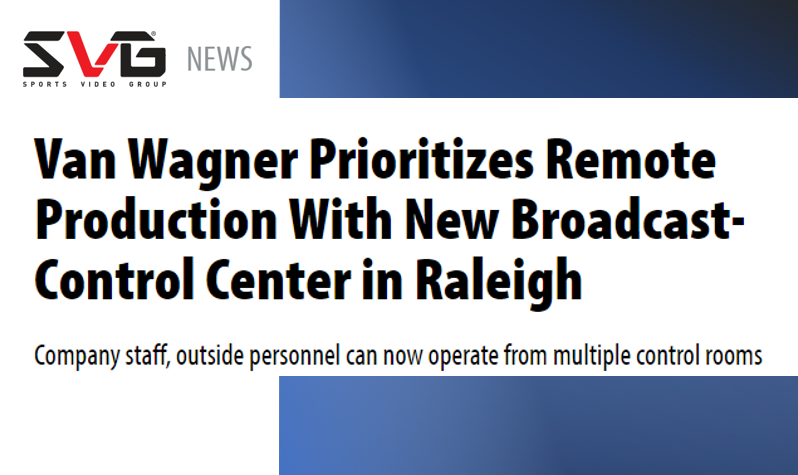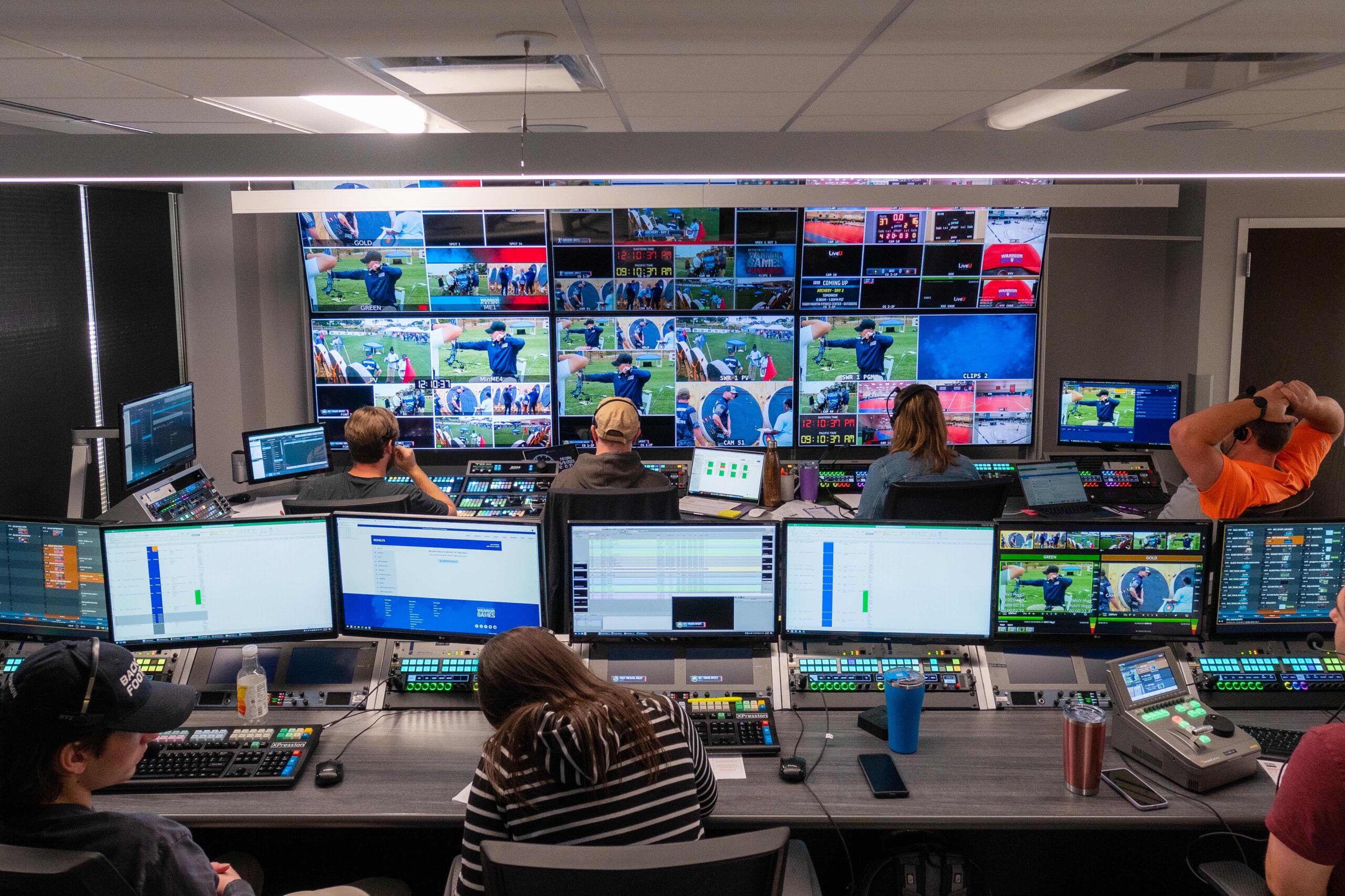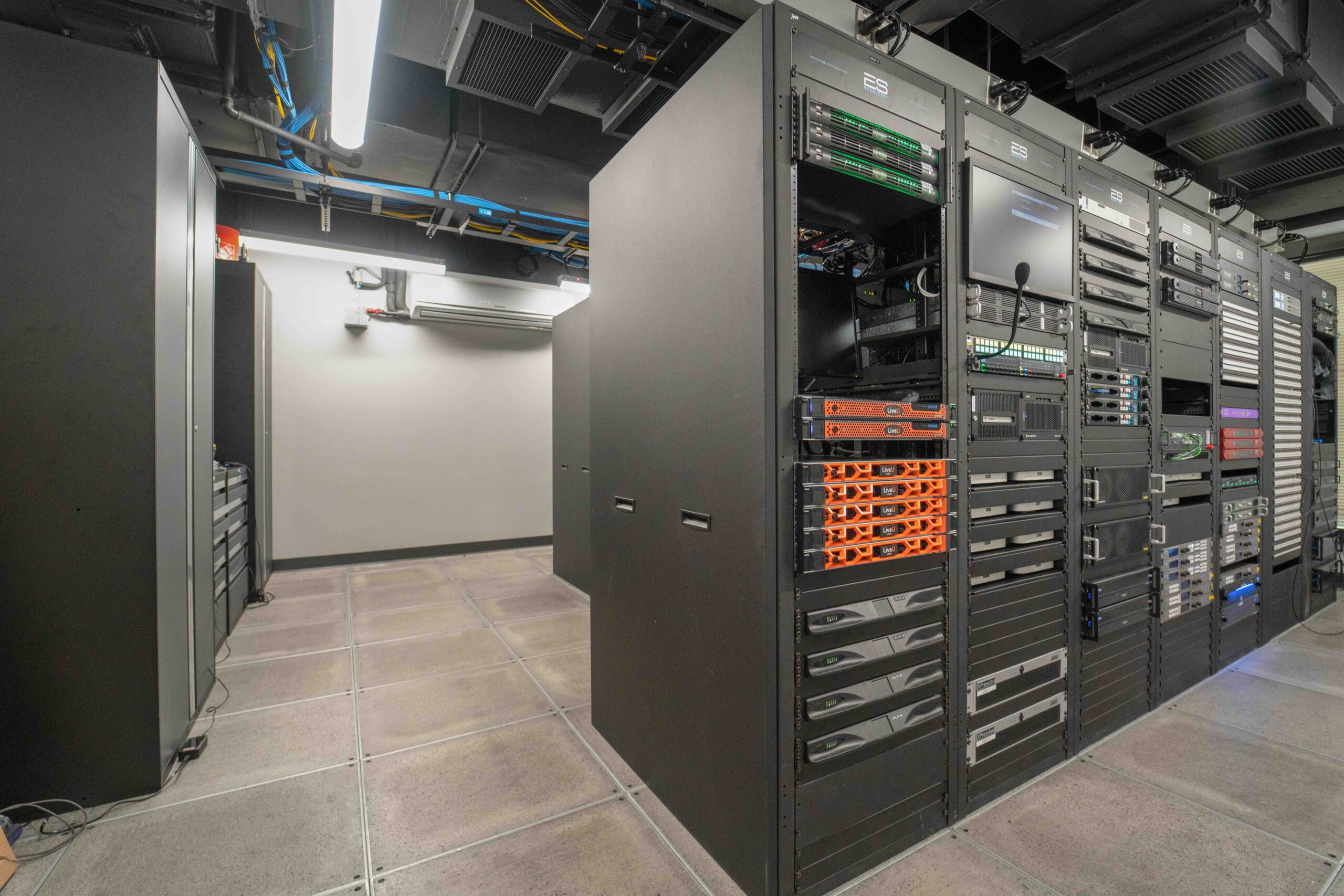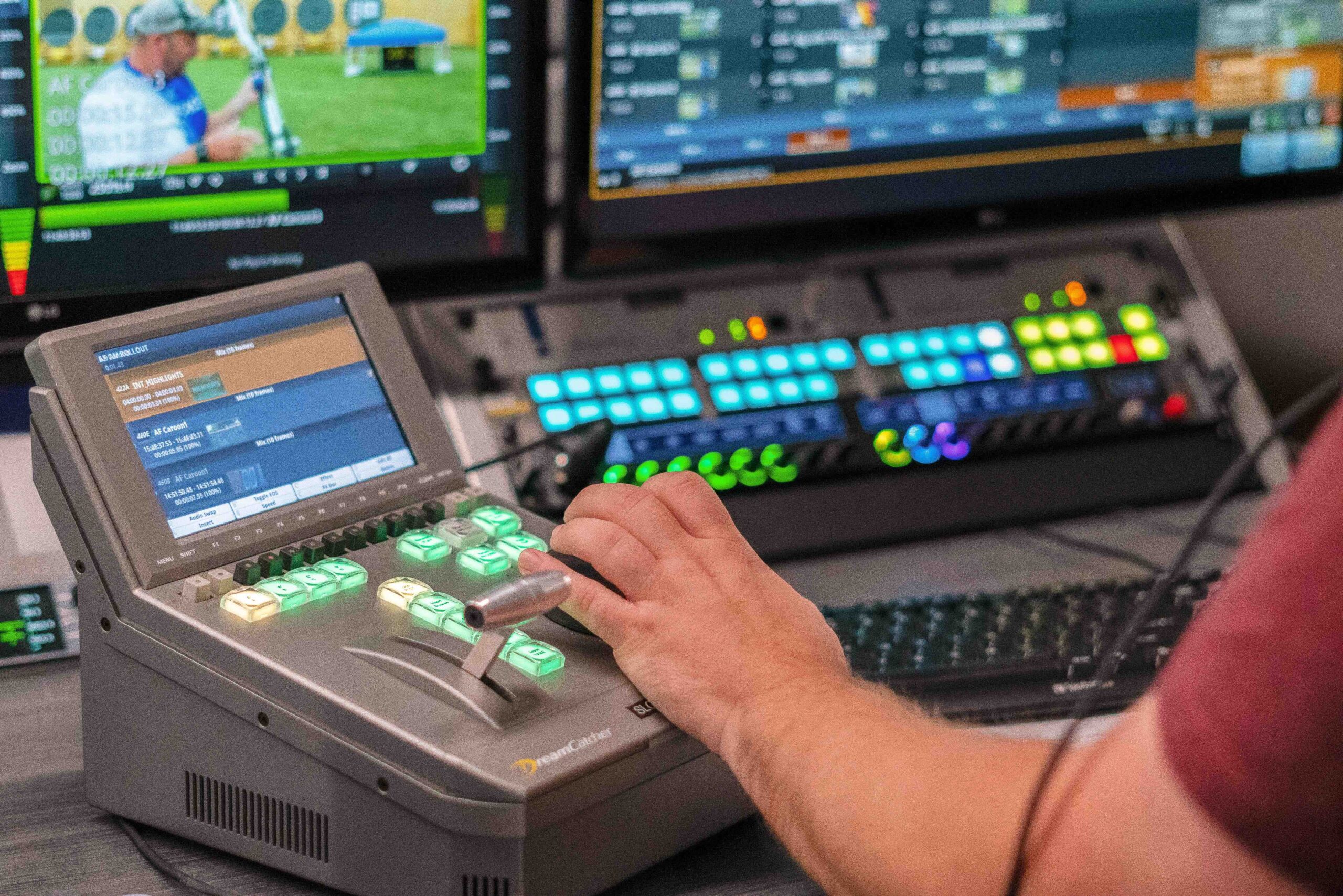Sports Video Group Features Van Wagner’s New Broadcast Control Center June 21, 2023

Van Wagner Prioritizes Remote Production With New Broadcast Control Center in Raleigh
Company staff, outside personnel can now operate from multiple control rooms
By Kristian Hernández, Senior Editor
Wednesday, June 21, 2023 – 8:05 am
The sports-video-production industry is undoubtedly headed toward placing remote production and similar workflows at the core of broadcast efforts, and Van Wagner is taking notice. With in-venue productions at the biggest professional and collegiate events on the yearly calendar, the company is taking a step down that path with a new broadcast control center at its office in Raleigh, NC.
“As we sit in our Raleigh office right now,” says Van Wagner President, Productions, Bob Becker, “we officially have a multimillion-dollar broadcast-control facility. We presented this idea to our ownership group, and they were behind it 100%, so we’re excited about this opportunity.”
Long-Awaited Dream: Pandemic-Related Delays Push Project Down the Road
Like most ideas generated over the past three years, the concept has taken new shape and been continually altered by the COVID-19 pandemic. The 2020 NFL Virtual Draft with NFL Network and ESPN was the catalyst to turning the decision on paper into a brick-and-mortar facility.
“We [produced that event] on 6-ft. tables and blew out our conference room by adding monitors everywhere,” says Becker. “[Director, Technical Operations,] Nate [McCoart] did a good job figuring out how to do that well while it was happening.”
The early stages in construction of a control room for remote production at Van Wagner facilities in Raleigh, NC
Virtualized productions and Zoom-based content were the rage and, at the time, allowed the industry to navigate the pandemic effectively. Although the entire industry was capitalizing on that trend, the temporary solution almost dictated the direction of the permanent facility.
“We went through the design phase and construction process to the point where we started knocking walls down,” says Becker. “Four months later, we realized that [this trajectory] wasn’t going to last forever, so we knew it wouldn’t be a great business model to build it this way.”
Teaming up with McCoart and Broadcast Facility Operations Manager Nelson Hurst, Becker and the rest of the crew worked closely with their partners to redefine the scope and vision for the project. Luckily, Van Wagner employs folks with extensive experience in the in-venue sector of the industry, and that experience entails knowledge of, and time spent inside, the newest control rooms across the country.
“The unique benefit we have,” says McCoart, “is that we’ve been in trucks from NEP Group and Game Creek Video and have worked in large control rooms like SoFi Stadium’s as well as control rooms in smaller venues. Our team has been able to experience the full breadth of what’s out there in the world, and we’ve taken that into how we want our space to function.”
Although the control room will reduce the travel costs and congestion of a full onsite team, the new facility will not change Van Wagner’s in-venue–production philosophy of having a majority of their team onsite for major tentpole events, such as this weekend’s two-game series between the St. Louis Cardinals and Chicago Cubs in London.
“That’s not going to stop [us from traveling to these bigger events] since it’s still difficult to do a live event from a remote control room,” says Becker. “When somebody makes a three-point shot or scores a touchdown, you need to see that in real time instead of in three seconds.”
Inside the Tech: ES Broadcast, Other Vendors Supply High-Quality Workflows
From a technological vantage point, Van Wagner enlisted the services of ES Broadcast for hardware and software in the control room. The main production wing of the control room features a Ross Carbonite Black Plus switcher with 36 inputs/25 outputs and 3 full M/E//4 mini M/E; a Ross Touchdrive 3S control panel with touchscreen and 3 Full M/E; two Ross XPression studio graphics system with three channels fill/key x 2 inputs and Datalinq server; an Evertz DreamCatcher replay server with 6 input/2 output and DCP controller; and a Newtek 3Play 3P1 replay server with 4 input/2 output SDI and additional IO via NDI. The main audio-control wing houses a Calrec Brio 36 console with 64×64 Dante IO and 64×32 analog IO; a 5.1- and stereo-capable system; JBL audio monitoring; and a TriggerPlay audio playback system.
Back of house, the space is powered through a 384×384 Evertz NEXX multiformat enterprise routing system, MADI and Dante audio routing by DirectOut and Focusrite, G&D IP KVM system, and Evertz Quartz control panels. Communications are accomplished with a Riedel Artist 1024 IP AES67 intercom system, Riedel RSP1232 and RSP1216 control panels, Unity Connect remote audio connectivity, and a Unity server mobile intercom system.
To receive incoming video feeds from a mobile unit or flypack with minimal operational issues, the facility relies on an approach that works well with any vendor: 12 inbound paths via LiveU LU4000, four outbound paths via LiveU LU810, 6 inbound x 6 outbound paths via TVU VS3500, 24 inbound paths via Haivision Makito SRT, 16 outbound paths via Haivision Makito SRT, and multiple paths of HLS, RTMP, RTMPS, RTSP, MPEG-2, MPEG-DASH, and VIXI encoding.
“Our model is to be transmission-agnostic, to be flexible and have the ability to easily integrate with anyone’s existing workflows,” says McCoart. “Since we partner with multiple providers, we wanted to scale their respective platforms into our space and execute whatever a client may be looking to do.”
For linear or digital broadcasts, facilities normally opt for an IP-based backbone. For in-venue productions of various scales, Van Wagner deployed the baseband option, but the 1080p facility has the capabilities to acquire signals in 4K and HDR when the time is right.
“Given the compact timeline that we were trying to fit into and the physical layout of our facility, we didn’t see the gain of building an IP facility to service remote productions right now,” McCoart adds. “We’ve built a 4K HDR–capable facility that’s currently at a baseband level but gives us the ability to scale our format as needed. We definitely looked at the future and what the next steps are.”
Balancing Responsibilities: Build a Control Room While Producing a Full Slate of Shows
Bringing this new space online has provided a ton of benefits, but it has also been a challenge to juggle this project with traditional in-venue duties. When the project was green-lighted, the crew were busy with domestic championships — Super Bowl, Men’s Final Four, Men’s and Women’s College World Series — and global showcases —World Baseball Classic. From Hurst’s perspective, as the one taking the lead on the control-room project, the hardest obstacle was the facility’s first official event: the 2023 Department of Defense Warrior Games, a multi-day production with more than 100 hours of programming and content shipped from San Diego via LiveU bonded cellular.
“We had two full crews shifting in and out over the 11 days,” he says. “It was great to get [this production] off the ground, but it has definitely been a challenge.”
To make things easier for the entire team moving forward, Hurst is stepping away from live events and focusing his efforts on keeping the building running. Alongside the massive show on day one, another major action item is to close out his current role and transition to another one in the midst of the facility’s first few days.
“We’re looking to get a dedicated engineer for the room to work with me,” he says. “We’re feeling out the market to see if we need to hire another producer as well as a field technician that we’ll have onsite.”
In addition, the global supply chain is still dealing with interruptions that throw off timelines and expectations. This unfortunate fact has forced the crew to work with what they have at the moment and think outside the box.
Says McCoart, “There has been a lot of collaboration on getting creative with our technical design and meeting deadlines affected by supply-chain issues.”
Despite the challenges, Van Wagner’s production and operations teams are working on finding the right formula to produce an engaging in-venue show from offsite. This remote-production philosophy will be used only for smaller shows, but, when the code is cracked, it’ll be a new avenue of problem-solving.
“We’re going to test a few things in Raleigh [that do not] affect the event,” says Becker. “When we figure that out, it’ll be a game-changer because it’ll give us the ability to elevate the experience and elevate our productions.”
Open for Business: Space Provides Canvas for Local Production Companies
Van Wagner is opening its control-room doors to other companies as a source of revenue. Teams that take advantage of the control room will receive as little or as many amenities from the Van Wagner staff as needed, whether that’s creative support to build a desired graphic through XPression, offering additional crewing for large- and small-scale shows, or solely renting out the production infrastructure.
“We’re invested in your production,” says Becker, “and we’re there for whatever is needed to be done.”
In addition to technical and operational know-how of modern-day control rooms, Van Wagner understands how the workforce interacts with certain equipment and workflows. Since joining from the University of North Carolina at Chapel Hill, Hurst has relied on his time at the collegiate ranks to recognize the workflows being used for collegiate-level productions at Duke and NC State and to comprehend the proficiencies of the local pool of talent. When it comes time to bring in third-party production companies, collegiate programs, and other local entities or to hire new staff to work remotely, the routines used at the third party’s own facility can be easily translated to Van Wagner’s control room.
“We have a big freelance pool of XPression users,” notes Hurst. “A lot of those folks already felt comfortable with [that workflow], so we considered the local talent in the market.”
Toward a Centralized Hub: Construction Starts on Second Control Room
Opening the new remote-production facility is a notable milestone for Van Wagner, but the company has eyes on further expansion. With all the technologies and equipment in the building, the crew is currently working on a second control room that mirrors a lot of the solutions in the main control room and has a completion date of mid August.
“[McCoart] knew that we could build another control room for a percentage of the cost,” says Becker. “It’s a very exciting time for Van Wagner.”
The additional space will feature a Ross Carbonite Black Plus switcher with 36 Inputs/25 outputs and 3 full M/E//4 mini M/E; a Ross Touchdrive 3S control panel with Touchscreen and 2 Full M/E; two Ross XPression studio graphics system with 3 channels fill/key x 2 inputs and Datalinq server; two XPression studio graphics systems with 3 channels fill/key x 2 inputs and Datalinq server; one Evertz DreamCatcher replay server with 6 input/2 output and DCP controller; NewTek 3Play 3P1 replay server with 4 input/2 output SDI and additional IO via NDI; Calrec Brio 36 console with 64×64 Dante IO and 64×32 analog IO; a 5.1- and stereo-capable system; JBL audio monitoring; and a TriggerPlay audio playback system.
Beginning with the two control rooms, the goal is to build a centralized broadcast center for the company and surrounding community. It would handle simultaneous productions of collegiate in-venue shows during the hectic spring season, fulfill in-venue duties for low-tier professional sports, and maximize money and crew time.
“We’re starting construction on the other side of the offices for a cafe, a room for brainstorming, edit rooms, and more,” says Becker. “We’re building not only a facility that will allow anyone to produce their event but a hub that promotes creativity.”
# # #
Join the growing list of broadcasters who have embraced REMI and are revolutionizing the way they produce and distribute live events.







